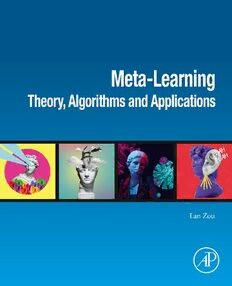Table Of ContentMETA-LEARNING
THE ELSEVIER AND MICCAI SOCIETY
BOOK SERIES
Advisory Board
NicholasAyache
JamesS.Duncan
AlexFrangi
HayitGreenspan
PierreJannin
AnneMartel
XavierPennec
TerryPeters
DanielRueckert
MilanSonka
JayTian
S.KevinZhou
Titles
Balocco,A.,etal.,ComputingandVisualizationforIntravascularImagingand
ComputerAssistedStenting,9780128110188.
Dalca,A.V.,etal.,ImagingGenetics,9780128139684.
Depeursinge,A.,etal.,BiomedicalTextureAnalysis,9780128121337.
Munsell,B.,etal.,Connectomics,9780128138380.
Pennec,X.,etal.,RiemannianGeometricStatisticsinMedical
ImageAnalysis,9780128147252.
Trucco,E.,etal.,ComputationalRetinalImageAnalysis,9780081028162.
Wu,G.,andSabuncu,M.,MachineLearningandMedicalImaging,9780128040768.
ZhouS.K.,MedicalImageRecognition,SegmentationandParsing,9780128025819.
Zhou,S.K.,etal.,DeepLearningforMedicalImageAnalysis,9780128104088.
Zhou,S.K.,etal.,HandbookofMedicalImageComputingandComputer
AssistedIntervention,9780128161760.
JieTian,etal.,RadiomicsandItsClinicalApplication
ArtificialIntelligenceandMedicalBigData,978012818101
HaofuLiao,etal.,DeepNetworkDesignforMedicalImageComputing
PrinciplesandApplications,9780128243831
META-LEARNING
Theory, Algorithms and
Applications
Edited by
L Z
AN OU
AcademicPressisanimprintofElsevier
125LondonWall,LondonEC2Y5AS,UnitedKingdom
525BStreet,Suite1650,SanDiego,CA92101,UnitedStates
50HampshireStreet,5thFloor,Cambridge,MA02139,UnitedStates
TheBoulevard,LangfordLane,Kidlington,OxfordOX51GB,UnitedKingdom
Copyright©2023ElsevierInc.Allrightsreserved.
Nopartofthispublicationmaybereproducedortransmittedinanyformorbyanymeans,electronicor
mechanical,includingphotocopying,recording,oranyinformationstorageandretrievalsystem,without
permissioninwritingfromthepublisher.Detailsonhowtoseekpermission,furtherinformationaboutthe
Publisher’spermissionspoliciesandourarrangementswithorganizationssuchastheCopyrightClearance
CenterandtheCopyrightLicensingAgency,canbefoundatourwebsite:www.elsevier.com/permissions.
ThisbookandtheindividualcontributionscontainedinitareprotectedundercopyrightbythePublisher(other
thanasmaybenotedherein).
Notices
Knowledgeandbestpracticeinthisfieldareconstantlychanging.Asnewresearchandexperiencebroadenour
understanding,changesinresearchmethods,professionalpractices,ormedicaltreatmentmaybecome
necessary.
Practitionersandresearchersmustalwaysrelyontheirownexperienceandknowledgeinevaluatingandusing
anyinformation,methods,compounds,orexperimentsdescribedherein.Inusingsuchinformationormethods
theyshouldbemindfuloftheirownsafetyandthesafetyofothers,includingpartiesforwhomtheyhavea
professionalresponsibility.
Tothefullestextentofthelaw,neitherthePublishernortheauthors,contributors,oreditors,assumeanyliability
foranyinjuryand/ordamagetopersonsorpropertyasamatterofproductsliability,negligenceorotherwise,or
fromanyuseoroperationofanymethods,products,instructions,orideascontainedinthematerialherein.
ISBN978-0-323-89931-4
ForinformationonallAcademicPresspublications
visitourwebsiteathttps://www.elsevier.com/books-and-journals
Publisher:MaraE.Conner
AcquisitionsEditor:TimPitts
EditorialProjectManager:SaraValentino
ProductionProjectManager:KameshR
CoverDesigner:MilesHitchen
TypesetbySTRAIVE,India
Tothosewho explore the world by intelligence.
This page intentionally left blank
Contents
Preface ix 4. Optimization-based meta-learning
Acknowledgments xi approaches
4.1 Introduction 61
1. Meta-learning basics and background
4.2 LSTMmeta-learner 62
4.3 Model-agnosticmeta-learning 68
1.1 Introduction 1
4.4 Reptile 76
1.2 Meta-learning 2
1.3 Machinelearning 5 4.5 Summary 85
References 85
1.4 Deeplearning 9
1.5 Transferlearning 12
1.6 Few-shotlearning 13 II
1.7 Probabilisticmodeling 14
1.8 Bayesianinference 15 Applications
References 18
5. Meta-learning for computer vision
I
5.1 Introduction 91
5.2 Imageclassification 96
Theory & mechanisms
5.3 Facerecognitionandfacepresentation
attack 123
2. Model-based meta-learning approaches 5.4 Objectdetection 131
5.5 Fine-grainedimagerecognition 137
2.1 Introduction 25 5.6 Imagesegmentation 143
2.2 Memory-augmentedneuralnetworks 26
5.7 Objecttracking 147
2.3 Meta-networks 32
5.8 Labelnoise 157
2.4 Summary 36 5.9 Superresolution 171
References 36
5.10 Multimodallearning 178
5.11 Otheremergingtopics 182
5.12 Summary 194
3. Metric-based meta-learning References 195
approaches
6. Meta-learning for natural language
3.1 Introduction 39 processing
3.2 ConvolutionalSiameseneuralnetworks 41
3.3 Matchingnetworks 44 6.1 Introduction 209
3.4 Prototypicalnetworks 48 6.2 Semanticparsing 212
3.5 Relationnetwork 53 6.3 Machinetranslation 218
3.6 Summary 56 6.4 Dialoguesystem 224
References 56 6.5 Knowledgegraph 230
vii
viii
Contents
6.6 Relationextraction 239 PartII:Electronichealthrecordsanalysis 312
6.7 Sentimentanalysis 243
8.6 Electronichealthrecords 312
6.8 Emergingtopics 246
6.9 Summary 255 PartIII:Applicationareas 317
References 255 8.7 Cardiology 318
8.8 Diseasediagnostics 321
8.9 Datamodality 324
7. Meta-reinforcement learning
8.10 Futurework 325
References 326
7.1 Backgroundknowledge 267
7.2 Meta-reinforcementlearning
9. Meta-learning for emerging applications:
introduction 270
Finance, building materials, graph neural
7.3 Memory 273
7.4 Meta-reinforcementlearning networks,programsynthesis,transportation,
methods 274 recommendation systems, and climate
7.5 Rewardsignalsandenvironments 285 science
7.6 Benchmark 286
7.7 Visualnavigation 288 9.1 Introduction 331
7.8 Summary 293 9.2 Financeandeconomics 334
References 294 9.3 Buildingmaterials 339
9.4 Graphneuralnetwork 340
9.5 Programsynthesis 349
8. Meta-learning for healthcare
9.6 Transportation 350
9.7 Cold-startproblemsinrecommendation
8.1 Introduction 299
systems 356
PartI:Medicalimagingcomputing 301
9.8 Climatescience 366
8.2 Imageclassification 302 9.9 Summary 368
8.3 Lesionclassification 304 References 369
8.4 Imagesegmentation 310
8.5 Imagereconstruction 311 Index 375
Preface
The idea for this book arrived 1 day rate.” In contrast to AGI, narrow AI means
when I was walking on the street, taking a the artificial agent can only tackle one spe-
break after a long-lasting experiment with cific task; otherwise, transfer learning or
my deep learning computer vision model. I retraining is needed in regimes of varying
saw my neighbor’s small public library—an or dissimilar tasks. AGI, on the other hand,
old bookshelf standing in his yard with a executes the ability of an artificial agent to
sign that said, “Enjoy.” This was my “spark learn or analyze intelligent tasks as human
moment” to write this book 4 years ago, beings do; even transcending what they
and Ihave appreciated this long journey. can achieve.
With the support of deep learning tech- Meta-learning used with deep neural
nology, many practical solutions reach networks delivers artificial agents with the
remarkable performance in various real- ability to solve diverse tasks, even unseen
worldscenarios.In2016,AlphaGoachieved orunknowntasks(orenvironments),relying
incredible results in chess-playing with onaverysmallamountofdata(suchaszero
humanbeings;however,quicklearningwith to five samples) within only a couple of
few samples remains one of the most com- gradientsteps.Examplesofthisarecovered
plex and common questions in AI research in Chapter 7, which discusses how meta-
and applications. Meta-learning can solve reinforcementlearninghelpsartificialagents
these issues. Tracing back to 1987, the achievevisualnavigationinunseentasks(or
€
“FatherofmodernAI”JurgenSchmidhuber environments), and in Chapter 6, which
and 1991 Turing Award recipient Yoshua shows how agents accomplish multilingual
Bengiobegantoexploremeta-learning.Since neural machine translation tasks with five
2015, meta-learning has become the most different target languages in low-source
attractiveresearch area in AI communities. situations.
TalkingattheBBCaboutthefutureofAI, This book reviews and explores 191
StephenHawking,thefamousphysicist,said state-of-the-art meta-learning algorithms,
“it would take off on its own and re-design involved in more than 450 crucial research.
itself at an ever-increasing rate” (Cellan- Itprovidesasystematicanddetailedinvesti-
Jones, R. (2014, December 2). Stephen gationofnineessentialstate-of-the-artmeta-
Hawking warns artificial intelligence could learningmechanismsand11real-worldfield
end mankind. BBC News. Retrieved from applications. This book attempts to solve
https://www.bbc.com/news/technology- common problems from deep learning or
30290540 (Retrieved 7 October 2022).)—this machine learning and presents the basis for
concepthasbecomeknownasartificialgen- researching meta-learning on a more com-
eral intelligence (AGI). Meta-learning is an plex level.Itoffers answersto the following
essential technique to achieve the capacity questions:
to “re-design itself at an ever-increasing What ismeta-learning?
ix

